.
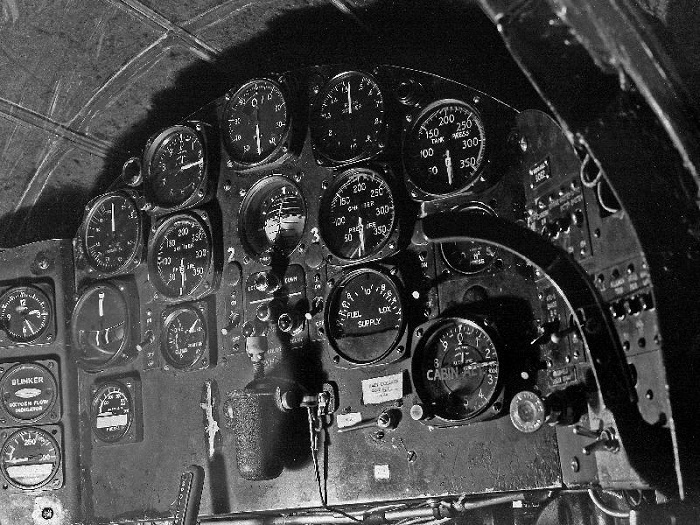
A Bell Aircraft Corporation X-1 series aircraft cockpit instruments display. The gages reflecting the airplane's parameters such as indicated pressure altitude, indicated airspeed, rocket chamber pressure, fuel and liquid oxygen supply, angle of attack, angle of sideslip, and Mach number are shown. Other information pertinent for the pilot to complete a successful flight is also displayed. (1949)
.
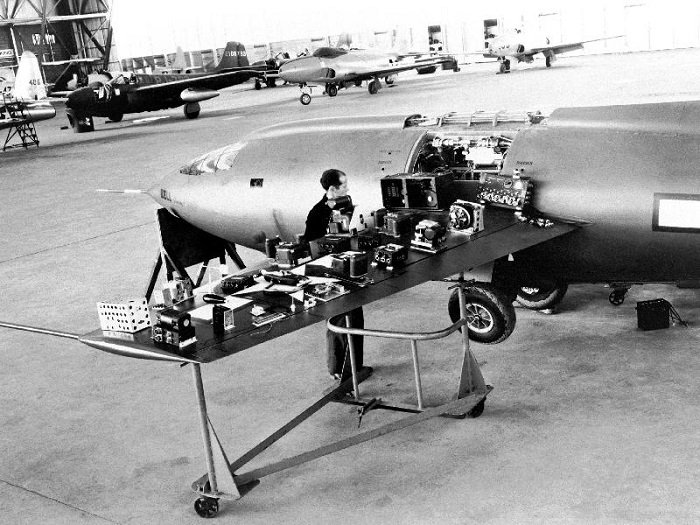
A Bell Aircraft Corporation X-1 series aircraft on display at an Open House at NACA Muroc Flight Test Unit or High-Speed Flight Research Station hangar on South Base of Edwards Air Force Base, California. (The precise date of the photo is uncertain, but it is probably before 1948.) The instrumentation that was carried aboard the aircraft to gather data is on display. The aircraft data was recorded on oscillograph film that was read, calibrated, and converted into meaningful parameters for the engineers to evaluate from each research flight.
In the background of the photo are several early U.S. jets. These include several Lockheed P-80 Shooting Stars, which were used as chase planes on X-1 flights; two Bell P-59 Airacomets, the first U.S. jet pursuit aircraft (fighter in later parlance); and a prototype Republic XP-84 Thunderjet. (1948)
.
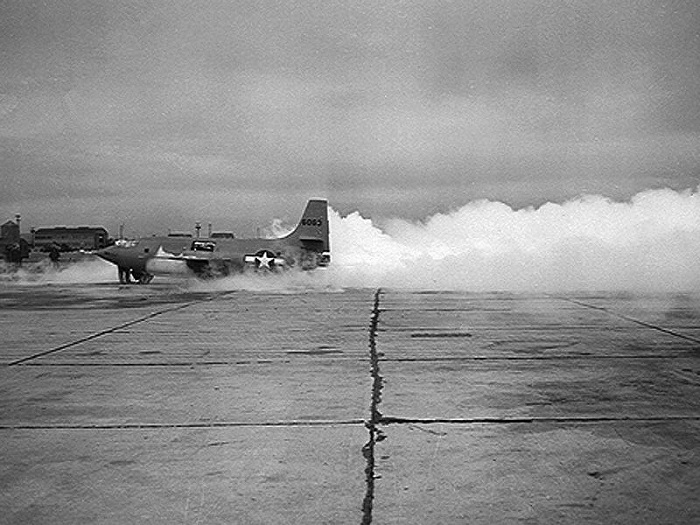
Ground engine test run on the Bell Aircraft Corporation X-1-2 airplane at NACA Muroc Flight Test Unit service area. Notice the frost on the lower part of the aircraft aft of the nose section. The frost forms from the mixture of the propellants (including liquid oxygen) in the internal tanks. This photograph was taken in 1947. The aircraft shown is still painted in its original saffron (orange) paint finish. This was later changed to white, which was more visible against the dark blue sky than saffron turned out to be. (1947)
.
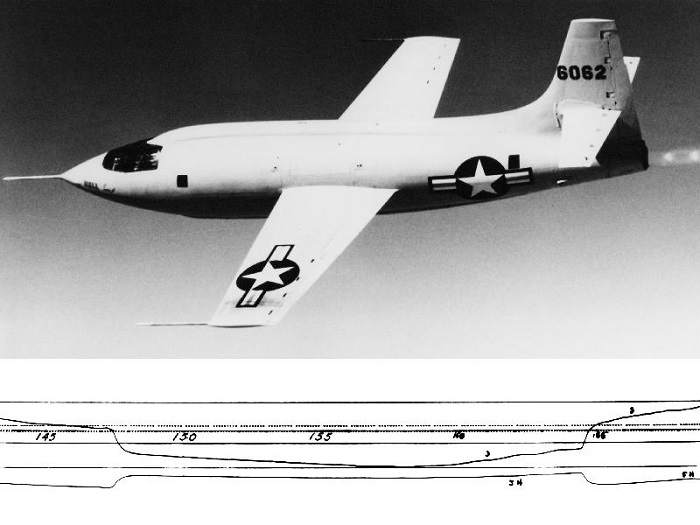
The Bell Aircraft Corporation X-1-1 (#46-062) in flight. The shock wave pattern in the exhaust plume is visible. The X-1 series aircraft were air-launched from a modified Boeing B-29 or a B-50 Superfortress bombers. Superimposed on this Air Force photo is the "Mach jump" paper tape data record of the first supersonic flight by Air Force Capt. Charles "Chuck" Yeager on 14 October 1947 in this aircraft.(1947)
.
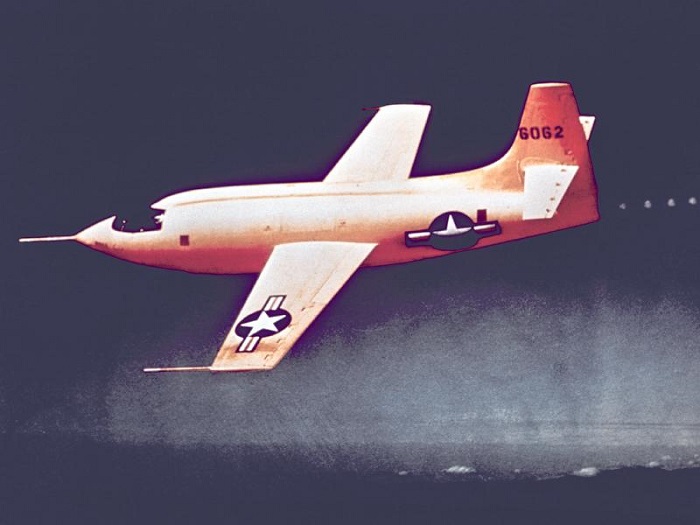
The Bell Aircraft Corporation X-1-1 (#46-062) in flight. The shock wave pattern in the exhaust plume is visible. The X-1 series aircraft were air-launched from a modified Boeing B-29 or a B-50 Superfortress bombers. The X-1-1 was painted a bright orange by Bell Aircraft. It was thought that the aircraft would be more visable to those doing the tracking during a flight. When NACA received the airplanes they were painted white, which was an easier color to find in the skies over Muroc Air Field in California. This particular craft was nicknamed "Glamorous Glennis" by Chuck Yeager in honor of his wife, and is now on permanent display in the Smithsonian Institution's National Air and Space Museum in Washington, DC. (1947)
.
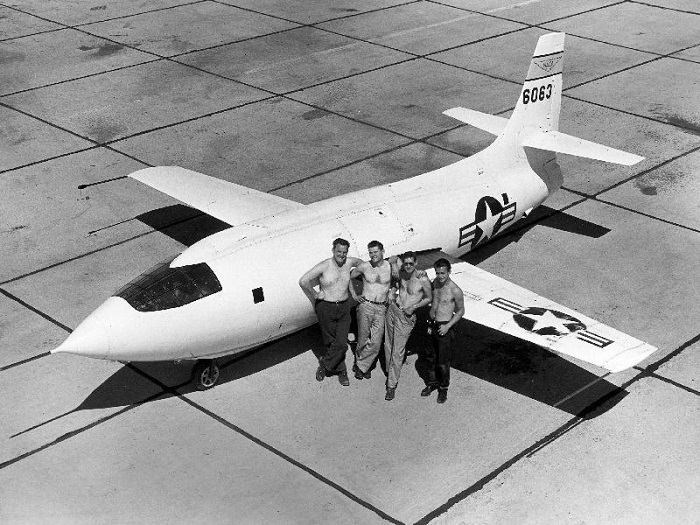
The Bell Aircraft Corporation X-1-2 parked on the ramp at NACA High-Speed Flight Research Station with the crew in 1949. Left to right: Edwin R. Edwards; Bud Rogers; Richard E. Payne, Crew Chief; and Henry "Kenny" Gaskins.
The NACA High-Speed Flight Research Station was located on the southern portion of Edwards Air Force Base at the edge of the Rogers Dry Lake in the Mojave Desert. The Mojave Desert, known for its blazing summer temperatures and normally clear skies, provided an ideal environment for pilots and engineers to test the research aircraft in flight. The airplane's crew members (mechanics) were an important part of this team. This photograph of them attests to the "blazing summer temperatures." The Bell X-1-2 was equipped with a 10-percent wing and an 8-percent tail (measured as the thickness divided by the chord of the airfoil), powered by an XLR-11 rocket engine, and air-launched from beneath a B-29A (45-21800). The aircraft investigated the transonic flight regime (Mach 0.7 to Mach 1.3). (1949)
.
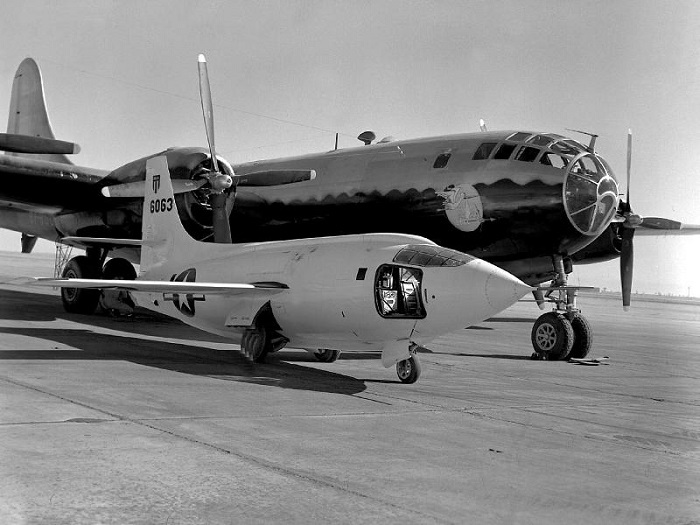
XS-1 on the ramp with the B-29 mothership in 1949. This is the second XS-1 built; it later was converted into the X-1E. Unlike the XS-1-1, which was flown by the Air Force, the XS-1-2 was flown mostly by Bell and NACA pilots. It gathered much more research data than the more famous XS-1-1, known as "Glamorous Glennis." (1949)
The Bell Aircraft Corporation X-1-2 Sitting on the ramp at NACA High-Speed Flight Research Station with the Boeing B-29 launch ship behind. The painting near the nose of the B-29 depicts a stork carrying a bundle which is symbolic of the Mothership launching her babe (X-1-2). The pilot access door is open to the cockpit of the X-1-2 aircraft. On the X-1-2's fin is the old NACA shield, which was later replaced with a yellow band and the letters "NACA" plus wings that were both black.
.
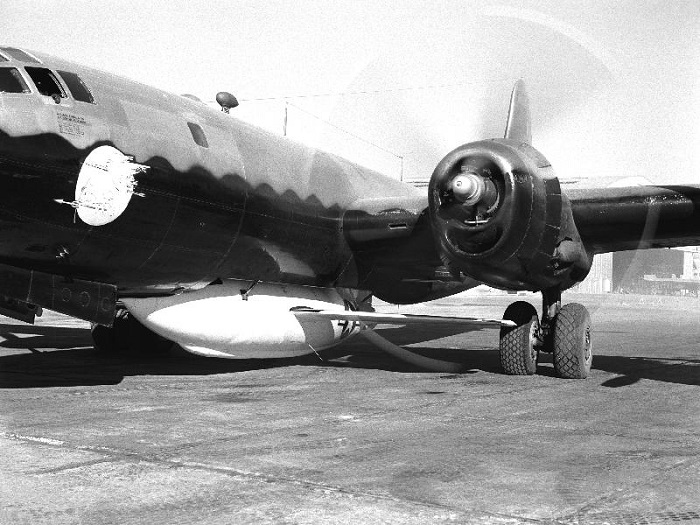
A roll-out of the Boeing B-29 Superfortress, bomber with the Bell Aircraft Corporation X-1-2 mated and ready for flight. NACA Flight 33 was flown on September 23, 1949, as a pilot familiarization flight with NACA pilot, John H. Griffith at the controls. Griffith reached a top speed of Mach 0.998 during the flight.(1949)
.
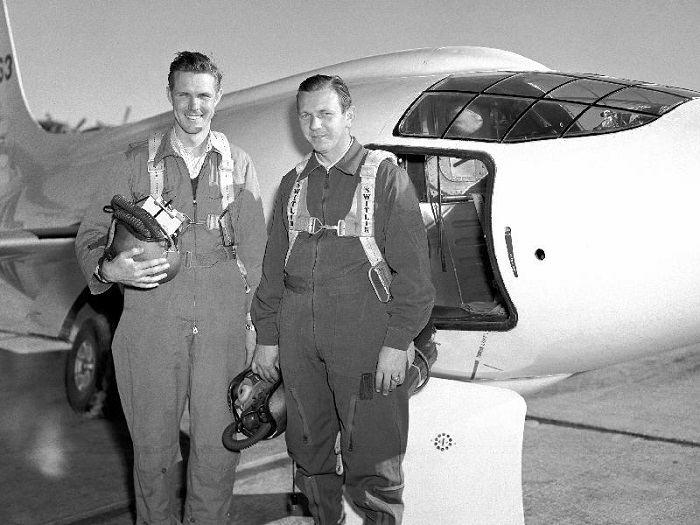
The Bell Aircraft Corporation X-1-2 and two of the NACA pilots that flew the aircraft. The one on the viewer's left is Robert Champine with the other being Herbert Hoover. Champine made a total of 13 flights in the X-1, plus 9 in the D-558-1 and 12 in the D-558-2. Hoover made 14 flights in the X-1. On March 10, 1948, he reached Mach 1.065, becoming the first NACA pilot to fly faster than the speed of sound.(1949)
.
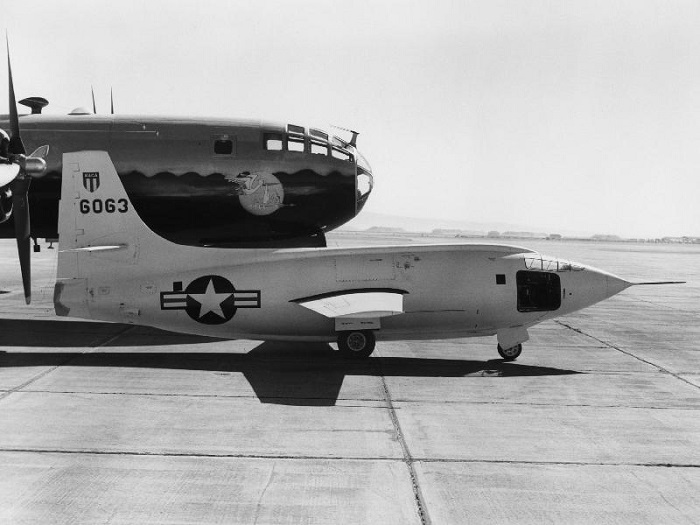
The Bell Aircraft Corporation X-1-2 Sitting on the ramp at NACA High-Speed Flight Research Station with the Boeing B-29 launch ship behind. The painting near the nose of the B-29 depicts a stork carrying a bundle which is symbolic of the Mothership launching her babe (X-1-2). The pilot access door is open to the cockpit of the X-1-2 aircraft. On the X-1-2's fin is the old NACA shield, which was later replaced with a yellow band and the letters "NACA" plus wings that were both black.(1949)
.
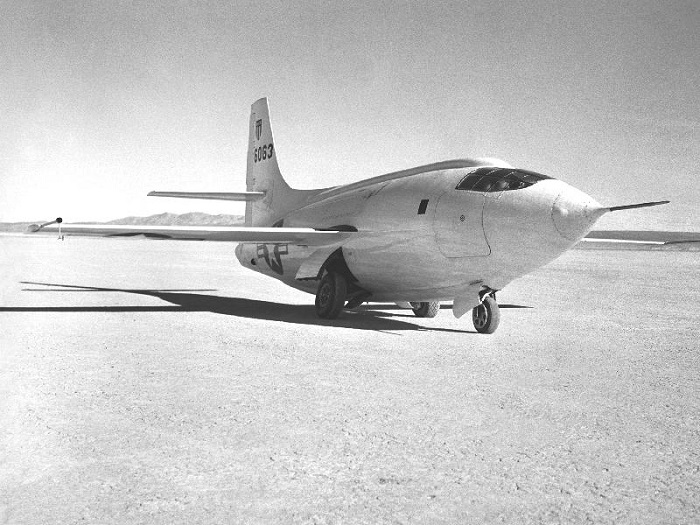
The Bell Aircraft Corporation X-1-2 sits on the Rogers Dry Lakebed at Muroc Air Force Base, California in 1949. Some airplane characteristics are:
Fuselage length, feet 31.0
Wing span, feet 28.0
Horizontal tail width, feet 11.4
Vertical tail height, feet 8.02 (above center line of plane).(1949)
.
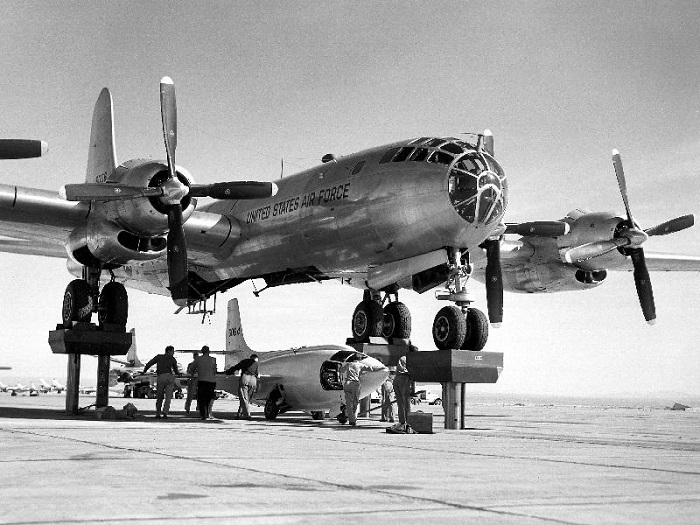
The third X-1 (46-064), known as "Queenie," is mated to the EB-50A (46-006) at Edwards AFB, California. Following a captive flight on 9 November 1951, both aircraft were destroyed by fire during defueling. This particular X-1 only flew twice, the first flight occurring on 20 July 1951. Bell pilot Joseph Cannon was the pilot on both flights, although the second flight was only a captive flight. Cannon was injured in the fire.(1951)
.
Fotos: NASA, Dryden
